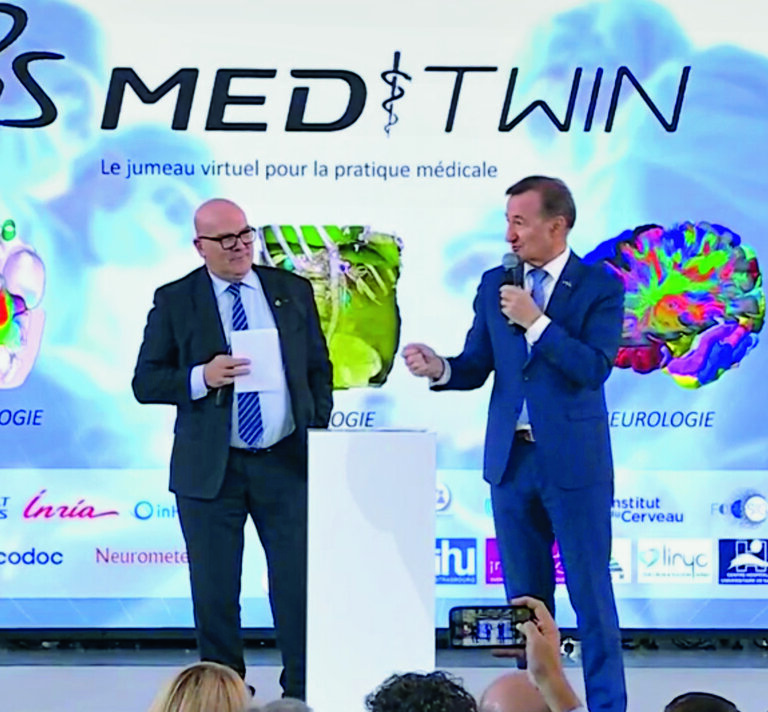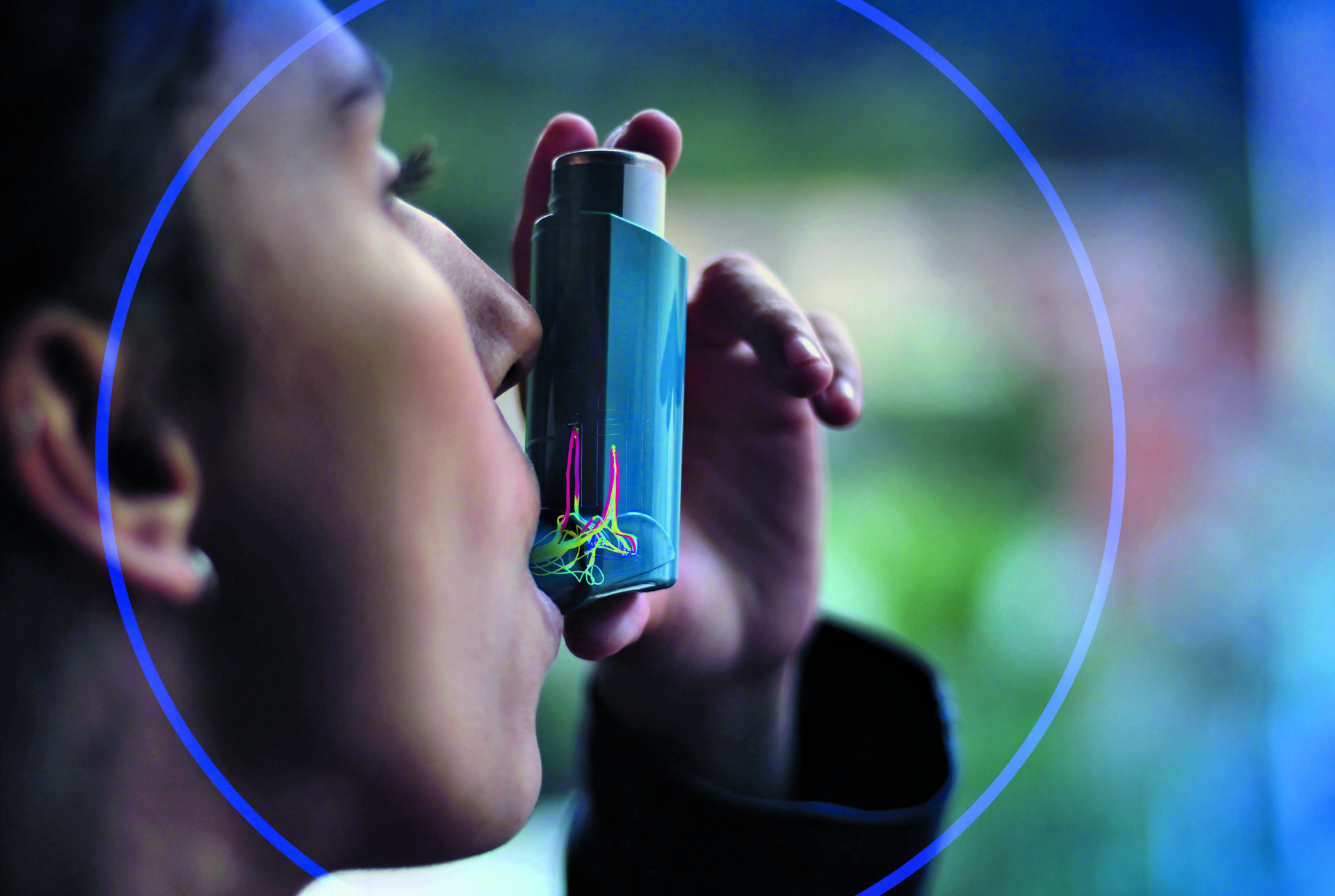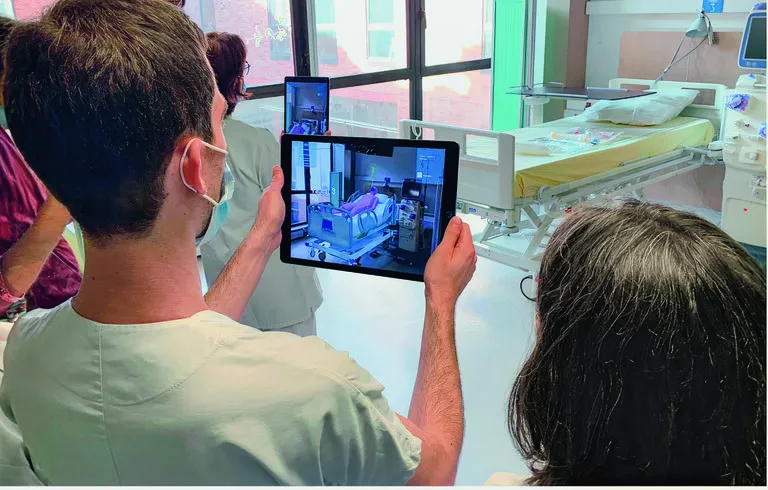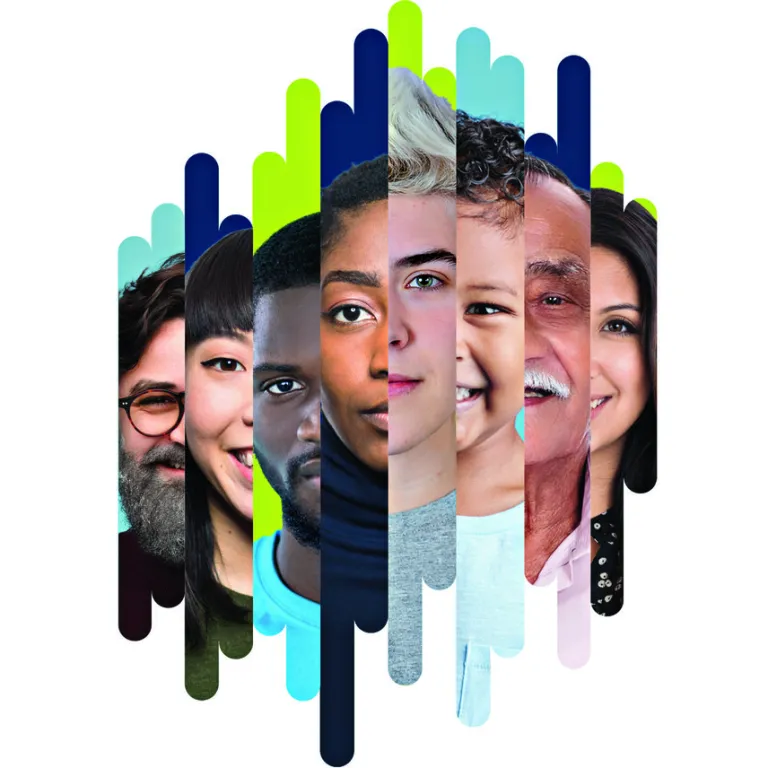Transforming Medicine with Virtual Twins for Precision Healthcare
Dassault Systèmes' virtual twin technology is revolutionizing healthcare through virtual twin technology to pioneer precision medicine and revolutionize personalized patient treatment strategies
UNTiL NOW
Medicine lacked the tools to visualize and imagine how best to treat the human body
FROM NOW ON
Virtual twins help create generative therapeutics and bioreactors at sustainable costs, helping to pioneer precision medicine and shift from cure to care - from treatment to prevention
Helping people live longer, healthier lives has always been the goal of medical professionals. Virtual universes are opening unlimited new horizons to revolutionize our understanding of how bodies react to disease and treatment, and to guide safer and more efficient methods for running clinical trials and manufacturing pharmaceuticals. From allowing key leaders to collaborate to scale up precision medicine, to preventing health hazards by modeling the circulation of airborne pathogens, to making clinical trials available to a wider audience, the 3DEXPERIENCE platform and our MEDIDATA brand portfolio are key allies in the life sciences & healthcare industry. Virtual universes empower health professionals to gain unprecedented insights into under-researched issues while improving patient care and outcomes. They’re also facilitating transformative approaches to healthcare, such as virtual twins of human organs to personalize medical diagnoses and treatments.
Leading the quest for precision medicine
Dassault Systèmes’ mission to extend virtual twin technology to better understand and treat the human body takes a major step through a new initiative that promises to radically transform healthcare. MEDITWIN will draw on the expertise of public and private French medical players to create personalized virtual twins of human organs.

Cardiovascular diseases are the leading cause of death globally, with an estimated 18 million deaths per year. Since 2014, Dassault Systèmes has led the Living Heart project to unite leading cardiovascular researchers, educators, medical device developers and practicing cardiologists to create personalized digital human heart models.
Dassault Systèmes is now leveraging that success by partnering with top French public and private organizations to take virtual twin technology to the next level and unlock its potential for various fields of healthcare. The MEDITWIN project aims to create a unified experience for healthcare professionals and patients, bringing together a wide range of disciplines, diseases and treatment types. MEDITWIN will develop personalized virtual twins of organs, metabolism and cancerous cells, allowing doctors to simulate care scenarios for each patient, for improved diagnosis and treatment.
For over forty years, Dassault Systèmes has pioneered virtual twins to transform the industrial world. By applying this technology to the human body, projects like MEDITWIN open new possibilities to transform healthcare. This alliance mobilizes the best of medicine, science and technology to standardize and disseminate virtual twins worldwide, providing a decisive learning ground for progress in medical science. The project will be developed over five years and is receiving financial support from the French government as part of its “France 2030” investment plan designed to support emerging technologies.
MEDITWIN is an example of how Dassault Systèmes is mobilizing public and private healthcare players to enable the industrialization, clinical validation and standardization of innovations to deploy technologies in a standardized way to benefit as many people as possible. MEDITWIN builds on Dassault Systèmes’ 3DEXPERIENCE platform and leverages the expertise of the 14 members of alliance, which includes seven French university hospitals, startups and Inria, the French science and technology research center. The virtual twins of human organs will be used in seven medical practices in neurology, cardiology and oncology. The resulting virtual healthcare products will be deployed on a sovereign, secure industrial cloud platform.
Dassault Systèmes is convinced that virtual twins are essential to the future of medicine, as they will reveal secrets of the human body to transform and personalize treatments for the best possible results. They will improve the efficiency of care, quality of multidisciplinary decision-making and effectiveness and safety of medical practices and interventions. Just as virtual twins improve the safety and efficacy of industrial processes or buildings design, they could someday help patients with rare epilepsies, Alzheimer’s disease, and cancer with personalized therapies.
“The MEDITWIN public-private alliance is a major step forward, mobilizing the best of medicine, science and technology to shape the future of healthcare. Virtual twin experiences are already a reality, and MEDITWIN will help standardize and disseminate them worldwide to benefit millions of patients.”
Revealing invisible health threats at hospitals
How can a hospital protect fragile patients from airborne infections? Saint-Louis Hospital in Paris used our Virtual Twin as a Service (VTaaS) to understand how invisible pathogens circulated in a dialysis unit and then took the necessary steps to reduce respiratory transmission to protect higher risk patients.

Picture a large, open hospital dialysis unit simultaneously treating nine patients suffering from kidney failure. The staff takes great measures to protect these immunocompromised individuals who are highly susceptible to infections. Yet, despite their best efforts, it’s difficult to avoid respiratory transmission of viruses.
This was the situation at Saint-Louis Hospital in Paris, triggering the hospital’s infection prevention and control team, working in conjunction with the virology department, to investigate options to limit virus transmission. They studied the levels of particles circulating in the air at different times of the day. The months-long study revealed that virus particles were circulating during the day – despite bio cleaning in between sessions – while at night hardly any pathogens were detected. Not only that, but the positivity rate of the samples also varied enormously from one end of the room to another.
Dr. Guillaume Mellon, head of the hospital’s Infection Control Unit, suspected an imbalance in the ventilation network. To identify the source of the issue, the team needed a tool to visualize the airflow within the ventilation system. Dr. Mellon turned to Dassault Systèmes, as he was familiar with our experience working on similar projects for flow modelization.
Using our Virtual Twin as a Service (VTaaS) approach, the first step was to create an accurate, full-scale virtual twin of the room, combining building blueprints with a 3D scan made on site with our HomeByMe mobile app. They then simulated particle contamination, using SIMULIA solutions on the 3DEXPERIENCE platform. This audit allowed Mellon’s team to accurately visualize and predict the transmission of respiratory viral particles through the air, identifying specific areas of the room that lacked airflow, allowing virus particles to cluster.
Our teams next used augmented reality on tablets to present their findings and recommendations to improve ventilation flows. This allowed hospital staff to view the virtual simulations while walking around the real-life setting, deepening understanding of exactly how virus particles are transmitted as they traveled towards the ceiling and into the air vents. It was a revelatory experience for Saint-Louis Hospital. The staff could confidently take measures to protect higher risk patients, such as improving ventilation in the dialysis department; a follow-up study confirmed that the hyper concentration of the virus in specific parts of the dialysis room had been eliminated. And this is just the start: Dassault Systèmes is now helping another unit at Saint-Louis Hospital on a similar project to prevent airborne infections.
“We are at a turning point in terms of new technologies. Some viruses could be less dangerous for ordinary people but critical for hematology patients. Now it’s possible to detect them and identify ways to prevent them from spreading. This could really help to reduce the risk of infection.”
Democratizing clinical trials
The combination of virtualization and data science is a driving force behind breakthroughs in clinical trials, from helping to identify candidates for innovative cancer therapies to ensuring diversity, equity, and inclusion is considered at every stage of a trial.
Trial Design for CAR-T: Using AI and data for broader, safer and repeatable clinical trials
Each year, 19 million new cases of cancer are detected worldwide(1), and experts anticipate a 47% increase in new cancer cases between 2020 and 2040. Since 2017, CAR-T drug cell therapy has become one of the main therapeutic options for treating blood cancers. The problem is that this treatment can have adverse side effects, including a severe one called cytokine release syndrome (CRS), which requires treatment at intensive care units. To date, it’s not been clear who is most susceptible to develop CRS, so CAR-T is limited to people able to access intensive care fast.
Through its rich heritage of supporting clinical trials, our MEDIDATA brand boasts the world’s largest dataset of patients treated with CAR-T therapy. Combining the power of AI and data science, the team has developed Trial Design for CAR-T to give medical professionals actionable insights to identify patients likely to suffer from CRS. The tool, used by pharma companies in the US and the EU, has been submitted for FDA approval. With clinical trials under increased pressure to improve safety and efficiency, not to mention diversity, the ultimate goal is to develop a repeatable, efficient, valuable model for delivering data and insights to pharmaceutical companies so that they can design better trials that can be available to a wider population.
MEDIDATA DIVERSITY PROGRAM: A multi-faceted approach to cultivate diversity across the clinical trial lifecycle
Historically and in modern times, clinical trials have lacked diversity in patient participation due to systemic barriers that hinder underrepresented groups from participating. This not only creates disparities in access to potentially life-saving treatments, but also hampers our understanding of treatment benefits and side effects among real world populations. To address this underlying issue, in September 2023 we launched the Medidata Diversity Program, the industry’s most comprehensive solution for improving diversity, equity, and inclusion in clinical trials.
Designed to embed diversity into every step of clinical trials, the Medidata Diversity Program comprises a suite of innovative and industry-leading solutions, including Medidata AI Intelligent Trials, Medidata’s Patient Insights Board, myMedidata Registries and Circuit Clinical’s site network. Diversity challenges come in various forms, requiring a multi-faceted approach; our program enables sponsors, CROs, sites, and patients to address these complex issues. Through Intelligent Trials, sponsors leverage industry-wide, site-level data to identify sites with a historical track record of enrolling diverse patients. The Patient Insights Board co-creates and ensures the most inclusive trial protocols. myMedidata Registries fosters continuous patient engagement, and Circuit Clinical’s site network facilitates trial access for underrepresented groups.
By championing diversity, this program positions Medidata as a catalyst for closing disparities and achieving true clinical trial success. We’re pleased to report that we’ve been recognized for our endless pursuit of improving clinical trials for all patients; the Medidata Diversity Program received the Best of Show Award at the 15th annual Summit for Clinical Ops Executives (SCOPE) in early 2024.
“True success in clinical trials is achievable through embracing diversity. The Medidata Diversity Program enables sponsors and CROs to incorporate diversity into every aspect of their trial strategy.”
Meet Emma Twin
Precision medicine will gradually make it possible for medical professionals to provide more precise diagnoses and treatment. But it requires the ability to visualize, test and predict. To help the public better understand how virtual twins can transform how the human body is understood and treated, we created an avatar and gave her an account on LinkedIn. Discover the Emma Twin campaign.
As the embodiment of a virtual twin, Emma Twin is able to test hundreds of treatments virtually to improve the lives of millions of real-life patients. Thanks to her 3D-modeled virtual body, doctors and researchers can analyze the effects of diseases and test new remedies without risk to real persons. She’s paving the way to precision medicine. But who is she? Our virtual consultant showcasing the power of virtual twins talks with Victoire de Margerie, Vice-President of Corporate Equity, Marketing & Communications.
Victoire de Margerie: Emma, you may not be a real human, but you have nevertheless had a busy year as our virtual twin consultant with demonstrating how a virtual twin can help transform how the human body is understood and treated. Tell us about some of the projects you’ve been involved with.
Emma Twin: With pleasure! Basically, I’m an avatar whose mission is to show how virtual twins like the one I embody can help create a more patient-centric healthcare model and improve healthcare for everyone. Trial and error testing takes time and resources, and can put human beings at risk. Virtual twins like me – 3D models of a human body – make it possible to visualize, test and understand how drugs affect a disease or the outcome of a surgery. So for example, running tests on an virtual twin of a human like me makes it possible to discover how a heart would respond in certain circumstances: running errands, exercising, or during deep sleep. How exciting is that?
V.M.: Very! People learn best from compelling stories. Through your posts on LinkedIn, you were able to share in a simple way a first-hand account of how virtual twins can impact a wide range of fascinating medical projects – from remote heart surgery to a cutting-edge corneal implant to exploring the effects of a drug under development on epileptic seizures. Our hope is that these examples will convince people of the benefits of virtual twin technology on healthcare. Emma, what do you think has been your biggest success so far?
E.T.: Hard to say, but one would be my participation in the MEDIDATA Synthetic Control Arm trial for recurrent glioblastoma (rGBM), an aggressive form of brain cancer. I took part in this hybrid external control arm to reduce the number of patients in the control therapy group, and I was able to provide rigorous scientific data to accelerate treatments and product development.
V.M.: We all appreciate your work with that test, Emma! Virtual twins are helping medical professionals quickly and confidently move away from the traditional “one-size-fits-all” approach to healthcare. And when they can treat each patient specifically, healthcare experts can gain deep insight into areas that have been under-researched while also improving patient care. There’s been a lot of work so far towards facilitating precision medicine thanks to virtual twins like you, Emma, and we’re excited to continue to forge into the next big frontiers involving the heart, brain and skin. We’re excited for you to continue as our virtual twin resource since we know you’ve got lots more to contribute. We can’t wait to share more of your stories!
Throughout 2023, Emma Twin was involved in several projects that will positively impact healthcare. Watch here to discover some of her work.







